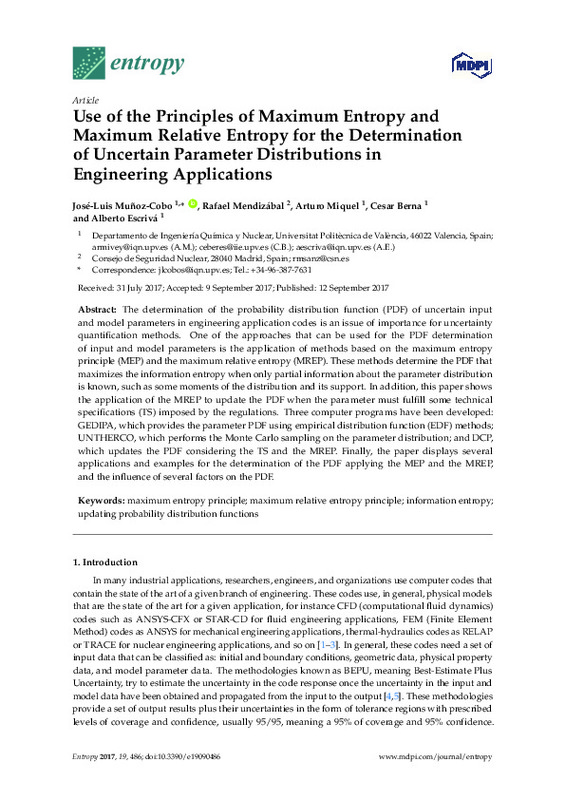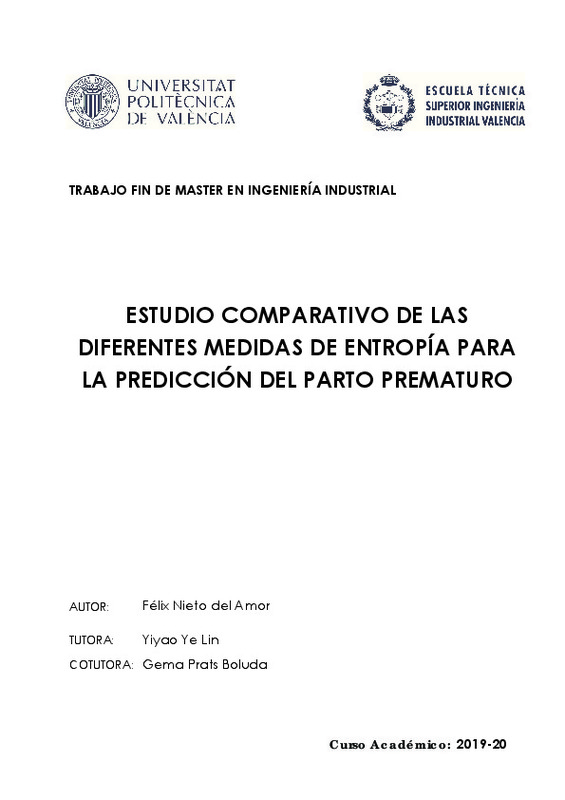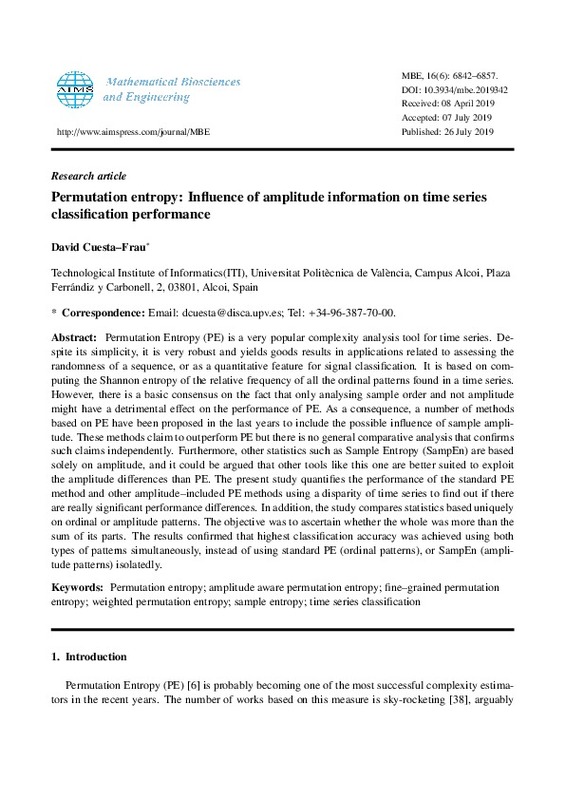JavaScript is disabled for your browser. Some features of this site may not work without it.
Buscar en RiuNet
Listar
Mi cuenta
Estadísticas
Ayuda RiuNet
Admin. UPV
Use of the Principles of Maximum Entropy and Maximum Relative Entropy for the Determination of Uncertain Parameter Distributions in Engineering Applications
Mostrar el registro sencillo del ítem
Ficheros en el ítem
| dc.contributor.author | Muñoz-Cobo, José-Luis
|
es_ES |
| dc.contributor.author | Mendizábal, Rafael
|
es_ES |
| dc.contributor.author | Miquel-Veyrat, Arturo
|
es_ES |
| dc.contributor.author | Berna, Cesar
|
es_ES |
| dc.contributor.author | Escrivá, Alberto
|
es_ES |
| dc.date.accessioned | 2018-06-14T04:27:25Z | |
| dc.date.available | 2018-06-14T04:27:25Z | |
| dc.date.issued | 2017 | es_ES |
| dc.identifier.issn | 1099-4300 | es_ES |
| dc.identifier.uri | http://hdl.handle.net/10251/104000 | |
| dc.description.abstract | [EN] The determination of the probability distribution function (PDF) of uncertain input and model parameters in engineering application codes is an issue of importance for uncertainty quantification methods. One of the approaches that can be used for the PDF determination of input and model parameters is the application of methods based on the maximum entropy principle (MEP) and the maximum relative entropy (MREP). These methods determine the PDF that maximizes the information entropy when only partial information about the parameter distribution is known, such as some moments of the distribution and its support. In addition, this paper shows the application of the MREP to update the PDF when the parameter must fulfill some technical specifications (TS) imposed by the regulations. Three computer programs have been developed: GEDIPA, which provides the parameter PDF using empirical distribution function (EDF) methods; UNTHERCO, which performs the Monte Carlo sampling on the parameter distribution; and DCP, which updates the PDF considering the TS and the MREP. Finally, the paper displays several applications and examples for the determination of the PDF applying the MEP and the MREP, and the influence of several factors on the PDF. | es_ES |
| dc.description.sponsorship | The authors are indebted to the Spanish Nuclear Regulatory Commission (CSN) for supporting this work. | es_ES |
| dc.language | Inglés | es_ES |
| dc.publisher | MDPI AG | es_ES |
| dc.relation.ispartof | Entropy | es_ES |
| dc.rights | Reconocimiento (by) | es_ES |
| dc.subject | Maximum entropy principle | es_ES |
| dc.subject | Maximum relative entropy principle | es_ES |
| dc.subject | Information entropy | es_ES |
| dc.subject | Updating probability distribution functions | es_ES |
| dc.subject.classification | INGENIERIA NUCLEAR | es_ES |
| dc.title | Use of the Principles of Maximum Entropy and Maximum Relative Entropy for the Determination of Uncertain Parameter Distributions in Engineering Applications | es_ES |
| dc.type | Artículo | es_ES |
| dc.identifier.doi | 10.3390/e19090486 | es_ES |
| dc.rights.accessRights | Abierto | es_ES |
| dc.contributor.affiliation | Universitat Politècnica de València. Departamento de Ingeniería Química y Nuclear - Departament d'Enginyeria Química i Nuclear | es_ES |
| dc.contributor.affiliation | Universitat Politècnica de València. Instituto de Ingeniería Energética - Institut d'Enginyeria Energètica | es_ES |
| dc.description.bibliographicCitation | Muñoz-Cobo, J.; Mendizábal, R.; Miquel-Veyrat, A.; Berna, C.; Escrivá, A. (2017). Use of the Principles of Maximum Entropy and Maximum Relative Entropy for the Determination of Uncertain Parameter Distributions in Engineering Applications. Entropy. 19(9):1-37. https://doi.org/10.3390/e19090486 | es_ES |
| dc.description.accrualMethod | S | es_ES |
| dc.relation.publisherversion | https://doi.org/10.3390/e19090486 | es_ES |
| dc.description.upvformatpinicio | 1 | es_ES |
| dc.description.upvformatpfin | 37 | es_ES |
| dc.type.version | info:eu-repo/semantics/publishedVersion | es_ES |
| dc.description.volume | 19 | es_ES |
| dc.description.issue | 9 | es_ES |
| dc.relation.pasarela | S\350940 | es_ES |
| dc.contributor.funder | Consejo de Seguridad Nuclear |











